This post may include affiliate links. Thank you for your support.
This Pesto Spaghetti Squash Casserole is an easy, healthier version of lasagna! Delicate strands of squash are layered with pesto ricotta, mozzarella and marinara. This 10-ingredient spaghetti squash recipe is budget-friendly, simple to prepare and a meal the entire family will love! (Healthy, Vegetarian, Gluten-free)
Table of Contents
- About this pesto spaghetti squash casserole
- What is spaghetti squash casserole?
- Tips for preparing and baking spaghetti squash
- FAQs: Casserole with squash
- Nutritional information
- How to make pesto spaghetti squash casserole?
- What to serve with spaghetti casserole?
- More spaghetti squash recipes!
- Pesto Spaghetti Squash Casserole
About this pesto spaghetti squash casserole
This baked pesto spaghetti squash casserole is a delicious and healthy alternative to lasagna.
Featuring delicate strands of spaghetti squash layered with thick, chunky marinara sauce, creamy basil pesto sauce fused ricotta, melty mozzarella, and freshly grated parmesan cheese. Finished with a generous sprinkling of pungent, fresh basil and more cheese, this spaghetti squash lasagna is robust and rich in flavor with significantly less calories than the traditional dish.
Bonus – this casserole is simple to prepare. With only 10 ingredients and 20 minutes of hands on preparation, you can have a hearty and healthy weeknight meal your entire family will love and devour!
If you’re looking to shake things up, switch up the basil pesto and use sun dried pesto instead.
What is spaghetti squash casserole?
Spaghetti squash casserole is an easy and healthier version of hearty classic spaghetti casserole. A flavorful tomato sauce is layered with cooked spaghetti squash and cheese, and then baked in the oven until hot and bubbly. Squash casserole can be made with meat sauce or plain tomato sauce for vegetarians.
Tips for preparing and baking spaghetti squash
Spaghetti squash is a delicious variety of squash with tender strands that resemble angel hair pasta or thin spaghetti! Spaghetti squash is harvested in the early fall season. It is savory in flavor with a hint of mild sweetness.
Spaghetti squash can be cooked in the microwave if you are in a hurry. However, the best way to cook spaghetti squash is in the oven.
How to cut spaghetti squash
Spaghetti squash needs to be cut into two halves before baking or roasting.
- Spaghetti squash has a very tough exterior, so I recommend using a sharp paring knife to make small incisions, lengthwise, along the side of the squash where you plan to cut it.
- Microwave the squash for 3-5 minutes to help soften the exterior before cutting. Allow the squash to cool until no longer hot to the touch.
- Place squash on a clean work surface and use a sharp knife to cut the squash lengthwise, from the top to the base, along the same line of incisions you made previously.
- Use a large spoon or ice cream scoop to scoop out the seeds and discard them before baking.
To bake spaghetti squash
To avoid watery, overcooked or crunchy strands of spaghetti squash, make sure you properly roast squash!
- Preheat oven to 400 degrees F. Line a rimmed baking sheet with parchment paper for easy clean up.
- Rub the cut sides of the squash with olive oil and season to taste with salt and pepper. Place the squash cut side down on the prepared baking sheet.
- Transfer to the oven and roast for 30-55 minutes, depending on the size of the squash. Squash is cooked when it is tender and easily pierced with a fork.
- Remove squash from oven and set aside until cool enough to handle.
- Use a fork to gently scrape along the inside of the squash to remove the noodle-like strands. Enjoy!
Tips for perfectly roasted spaghetti squash
- Bake the squash at moderately high heat (400 degrees F) for the most flavorful, slightly caramelized strands of squash.
- Avoid roasting cut side up or water will pool inside the squash.
- Check the squash for doneness. Smaller spaghetti squash will take around 30 minutes, while large squash can take up to 55 minutes.
FAQs: Casserole with squash
How to prevent watery spaghetti squash casserole?
While spaghetti squash is a wonderful, healthy alternative to pasta, isn’t an actual replacement or true substitution for pasta! Spaghetti squash has a tendency to get a bad reputation because it does release water when cooked.
To prevent watery spaghetti squash, it is imperative you place the cooked strands of spaghetti squash in a kitchen or tea towel and squeeze out the excess water before proceeding with assembling the casserole! Also, make sure you are properly cooking spaghetti squash (described above).
How long will spaghetti squash casserole keep?
Leftover casserole should be stored in an airtight container in the refrigerator. Properly stored, the casserole will last for up to 4 days.
Can you freeze spaghetti squash casserole?
Baked Pesto spaghetti squash casserole can be frozen either assembled and baked or unbaked.
How to freeze casserole with spaghetti squash
To freeze unbaked casserole: Prepare and assemble the squash casserole according to the recipe instructions. Make sure you assemble the casserole in a dish that can go straight from the freezer into a hot oven (avoid ceramic, porcelain or glass baking dishes). Cover the dish with a lid or a layer of plastic wrap followed by a layer of aluminum foil. The unbaked casserole can be stored in the freezer for up to 3 months.
To freeze baked casserole: Prepare, assemble and bake the casserole according to the instructions in the recipe. Allow the casserole to come to room temperature before wrapping with a layer of plastic wrap and then a layer of aluminum foil. The baked casserole can be stored in the freezer for up to 3 months.
How to reheat this casserole recipe?
Reheating unbaked casserole: Uncover the casserole and transfer the frozen casserole directly to an oven preheated to 350 degrees. Bake for 45 minutes, or until warmed throughout.
For reheating leftovers: Defrost the casserole in the refrigerator overnight if frozen.
- To reheat in the oven: When ready to eat, reheat in an oven preheated to 350 degrees F. Bake until heated throughout.
- To reheat in the microwave: Alternatively, (defrosted) leftovers can be reheated in the microwave until warmed throughout! Microwave individual servings of casserole at 50% power for 1-3 minutes, or until warmed throughout.
Pro-Tip: If you are using a glass baking dish, make sure you let the casserole sit on the counter and come to room temperature before placing in the oven. Glass can easily crack and shatter if the temperature changes from cold to hot too quickly!
Cook’s Note: Spaghetti squash does release water when reheated, however the water won’t hurt anything!
Nutritional information
Is baked spaghetti squash casserole healthy?
This Pesto spaghetti squash casserole recipe is a lighter, healthier alternative to traditional lasagna! It has all the comforting appeal of a lasagna – layers of melty cheese, chunky tomato sauce and dollops of ricotta – but with significantly less calories and carbohydrates per serving!
This casserole is also naturally gluten-free and vegetarian. It is also packed with protein and fiber which will help keep you feeling fuller for longer.
Healthy benefits of spaghetti squash
Spaghetti squash has a low calorie and high fiber content. Plus, it is rich in minerals, antioxidants, and vitamins, such as C and B6.
How many calories in spaghetti squash casserole?
The precise number of calories in baked pesto spaghetti squash will depend on the recipe and exact ingredients used. This pesto spaghetti squash casserole serves eight and has approximately 290 calories and 16 grams of carbohydrates per serving.
How to make pesto spaghetti squash casserole?
Baked pesto spaghetti squash is extremely easy to make.This recipe only requires 10 ingredients and 20 minutes of hands on preparation:
- Roast the spaghetti squash: Rub the cut sides of the squash with olive oil and season to taste with salt and pepper. Place the squash, cut side down, on the baking sheet. Transfer a 400-degree oven and bake for 40-50 minutes, or until the squash is fork tender. Set aside until cool enough to handle. Then, use a fork to gently scrape out the strands of squash and discard squash “shells”. In batches, transfer the squash “noodles” to a kitchen towel or tea towel. Squeeze to remove and discard the excess water from the squash. Transfer the strands of squash to a bowl and set aside. (Keep the oven on!)
- Make the pesto ricotta mixture: In a medium bowl, combine the ricotta with the pesto, garlic, and parmesan cheese. Season with salt and black pepper and stir to combine. Then, set aside.
- Add flavor to your marinara: Stir fresh basil into your marinara sauce. Then taste it and adjust your sauce with salt and pepper.
- Assemble casserole: Grease a 9×13-inch casserole dish. Spread a thin layer of tomato sauce onto the bottom of the dish. Top with half of the spaghetti squash noodles. Then, top with half of the ricotta mixture. Next, layer on half of the remaining tomato sauce and half of the mozzarella cheese. Repeat with the remaining squash noodles, ricotta and tomato sauce. Finally, sprinkle with the rest of the mozzarella and parmesan cheeses.
- Bake: Bake in the oven for 25-30 minutes or until the top of the casserole is bubbly.
- Serve: Let cool for 10 minutes before garnishing with cheese and basil. Serve and enjoy.
Step-by-step photos: make spaghetti squash casserole
What to serve with spaghetti casserole?
Since squash casserole is a heartier main dish, it goes best with light and crisp side dishes.
- Bruschetta
- Garlic Bread
- Caprese Salad
- White Bean Salad
- Avocado Salad
- Caesar Salad
- Italian Chopped Salad
- Chopped BLT Salad with Avocado
- Cheese Tortellini Pesto
- Sauteed Mushrooms or Amazing Mushrooms in Marinade
- Roasted Artichokes, Asparagus, Broccoli or Brussels Sprouts
- Sauteed Vegetable Medley
- Meatballs – if you have meat eaters at the table, I recommend serving a side of meatballs baked in tomato sauce!
Until next week, friends, cheers – to healthy comfort food!
Cheyanne
Craving MORE? Follow all the deliciousness on Facebook, Pinterest and Instagram!
More spaghetti squash recipes!
The best Pesto Spaghetti Squash Casserole Recipe👇
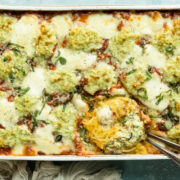
Pesto Spaghetti Squash Casserole
Equipment
- Rimmed Baking Sheet
- 2 Medium Mixing Bowls
- 9x13-inch Casserole Dish
Ingredients
- 1 large Spaghetti Squash (about 4 to 4 ½ pounds) – halved lengthwise and seeds removed (SEE NOTES)
- 1-2 TBS Extra Virgin Olive Oil - to taste
- Kosher Salt & Ground Black Pepper
- 3 Cups Thick Marinara Sauce (SEE NOTES)
- ¼ Cup Fresh Basil Leaves – thinly sliced, plus more for garnish
- 2 Cups Whole Milk Ricotta Cheese
- ½ heaping Cup Basil Pesto – Homemade or Store bought
- 1 clove Garlic – finely chopped
- 2/3 Cup Freshly Grated Parmesan Cheese - DIVIDED
- 8 ounces Fresh Mozzarella – torn or shredded
Instructions
- Roast the spaghetti squash: Heat oven to 400 degrees F. Line a rimmed baking sheet with parchment paper for easy clean up. Rub the cut sides of the squash with olive oil and season to taste with salt and pepper. Place the squash, cut side down, on the prepared baking sheet. Transfer to the oven and bake for 40-50 minutes, or until the squash is tender and easily pierced with a fork. When squash is cooked and cool enough to handle, use a fork to gently scrape out the strands of squash and discard squash “shells”. Transfer the squash strands, in batches, to a kitchen towel or tea towel. Squeeze the excess water out of the spaghetti squash. Transfer to a bowl and set aside. Keep the oven at 400 degrees F.
- While the spaghetti squash roasts, make the pesto ricotta mixture: In a medium bowl, combine the ricotta with the pesto, garlic, and 1/3 cup parmesan cheese. Season with ¼ teaspoon salt and 1/8 teaspoon ground black pepper. Stir to combine. Set aside.
- Add flavor to your marinara: Stir fresh basil into your marinara sauce. Taste. Adjust your sauce to taste with salt and pepper. Set aside.
- Assemble the casserole: Grease 9x13-inch casserole dish. Spread ¾ cup of the tomato sauce onto the bottom of the dish. Top with half of the cooked spaghetti squash noodles. Top with half (1 ½ cups) of the ricotta mixture followed by half (1 ¼ cups) of the remaining tomato sauce and half (4 ounces) of the mozzarella cheese. Repeat with the remaining squash noodles, ricotta and tomato sauce. Sprinkle with remaining mozzarella cheese and remaining 1/3 cup parmesan cheese.
- Bake: Bake in the oven (preheated to 400 degrees F) for 25-30 minutes or until the top of the casserole is browned and bubbly.
- Serve: Let cool 10 minutes before serving. Garnish with more parmesan cheese and fresh basil if desired. Enjoy!
Notes
- You can use one large spaghetti squash or two smaller ones. Just make sure overall your squash measures roughly 4 to 4 ½ pounds. If you meal prep and have cooked spaghetti squash on hand, the equivalent is about 9 cups of cooked spaghetti squash strands.
- To make the squash easier to cut in half: Use the tins of a fork to poke the outside of the squash a few times. Place the squash on a microwave safe plate and microwave on high for 3-5 minutes to soften the exterior before cutting.
- If you like things spicy, add a teaspoon of crushed red pepper flakes to your marinara sauce!
- For a different variation, try using Vodka Sauce instead! My easy homemade vodka sauce is delicious in this casserole! For recipe, click HERE.
- Need protein? Feel free to add cooked, shredded chicken, turkey, ground beef or ground pork to the casserole! Or, if you prefer meat, try making this with homemade Bolognese instead of the tomato sauce!
- Gluten-free? Make sure your marinara sauce is gluten-free!
- Heat oil in a medium saucepot over medium heat. When the oil shimmers, add the onions and season with salt and pepper. Cook, stirring occasionally, for 5 minutes or until the onion are softened. Add in the garlic, paprika and oregano. Cook, stirring, until fragrant, about 30 seconds. Add in the tomato paste and cook, stirring, until the tomato paste starts to caramelize, about 1-2 minutes. Add in the tomatoes and season with salt and pepper.
- Bring to a rapid simmer and then immediately reduce to a gentle simmer. Cook, stirring occasionally, for 40-45 minutes, or until sauce is thick. (Stir in basil from recipe above). Taste and adjust for seasoning. Remove from heat and set aside.
Nutrition
Did you make this recipe?
Mention @nospoonnecessary on Instagram and tag it #nospoonnecessary!
©No Spoon Necessary. All images and content are under copyright protection. Please do not use any images without prior permission. If you want to reference this recipe please do so by linking directly back to this post.

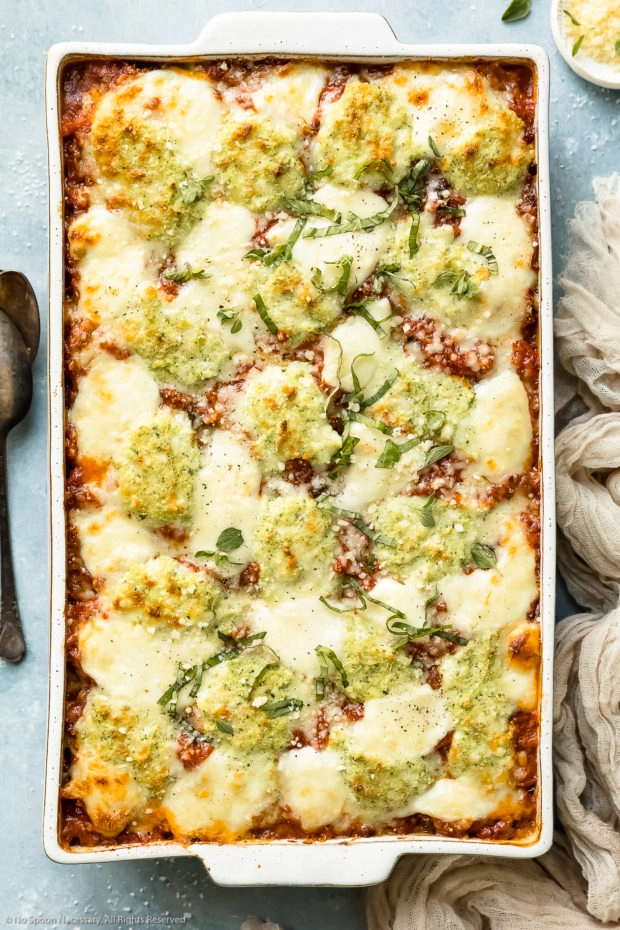
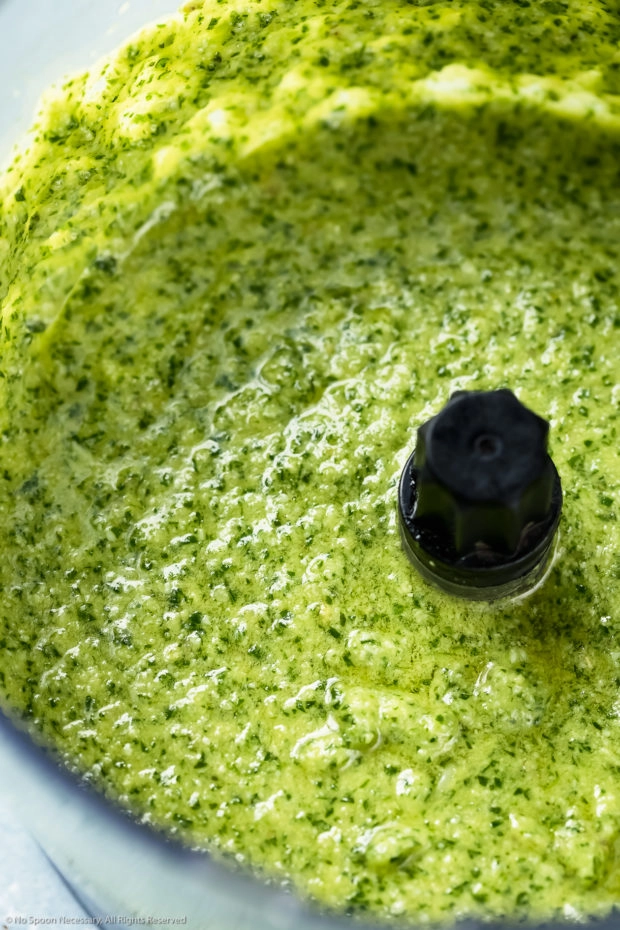
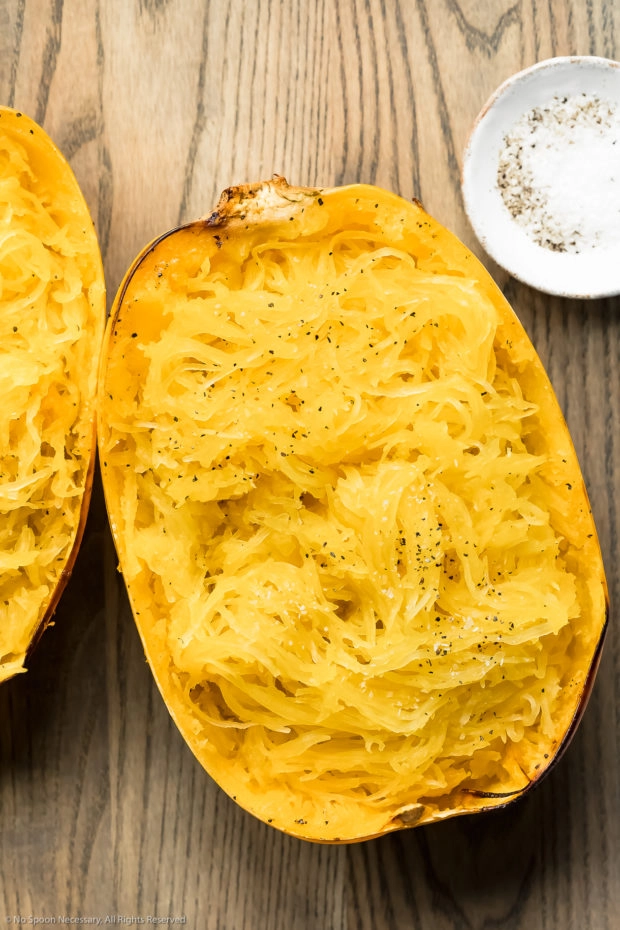
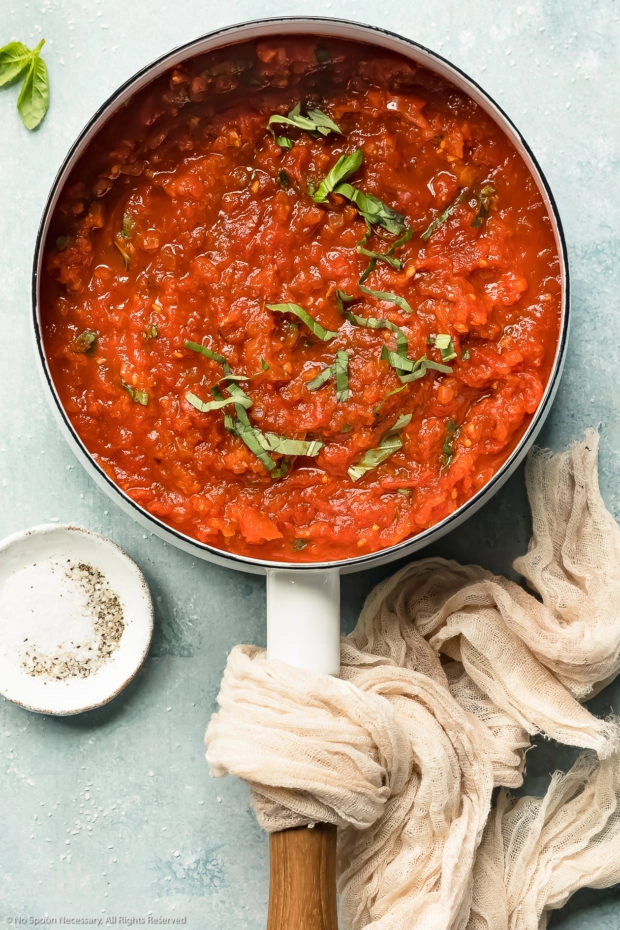
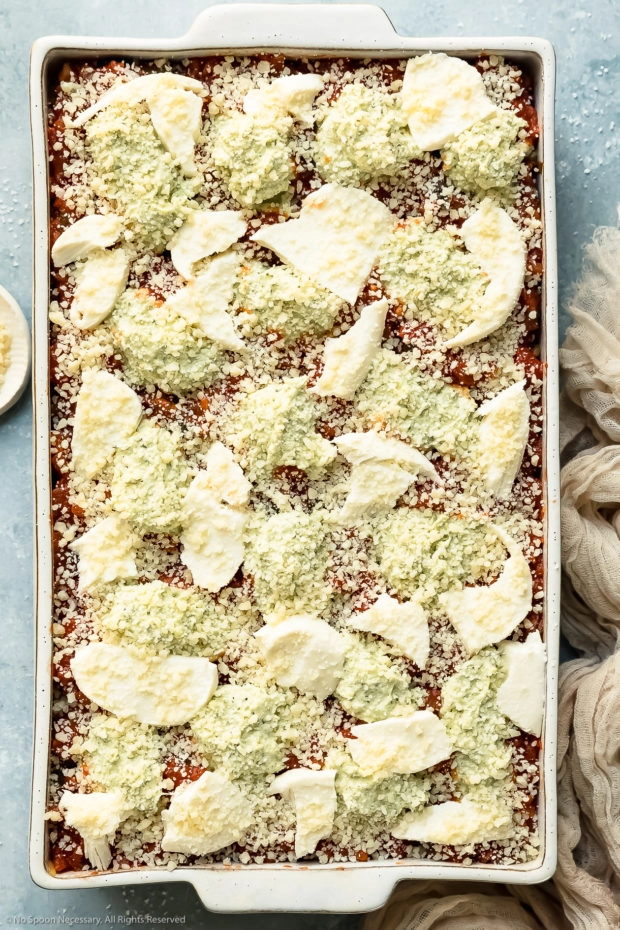
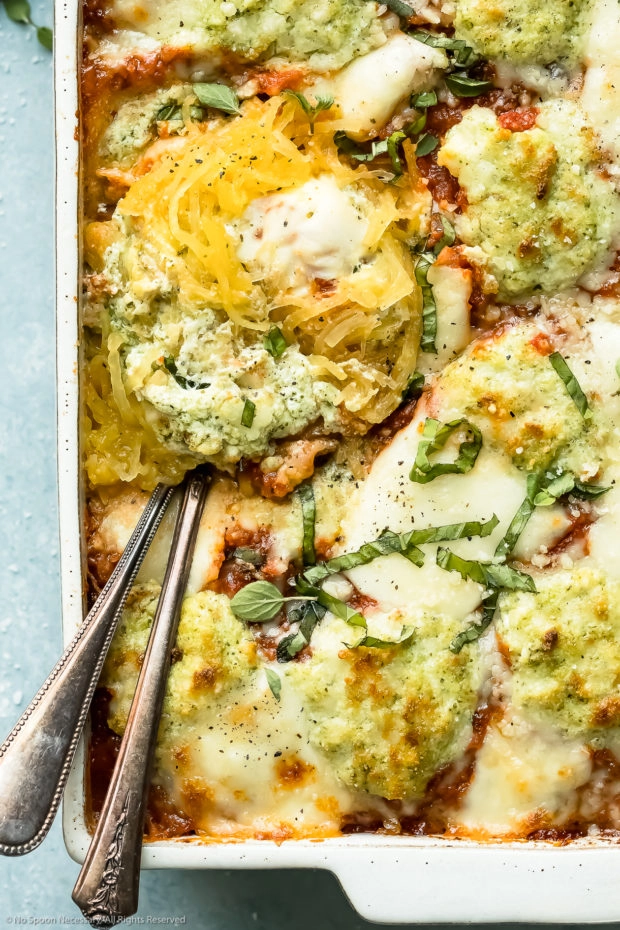
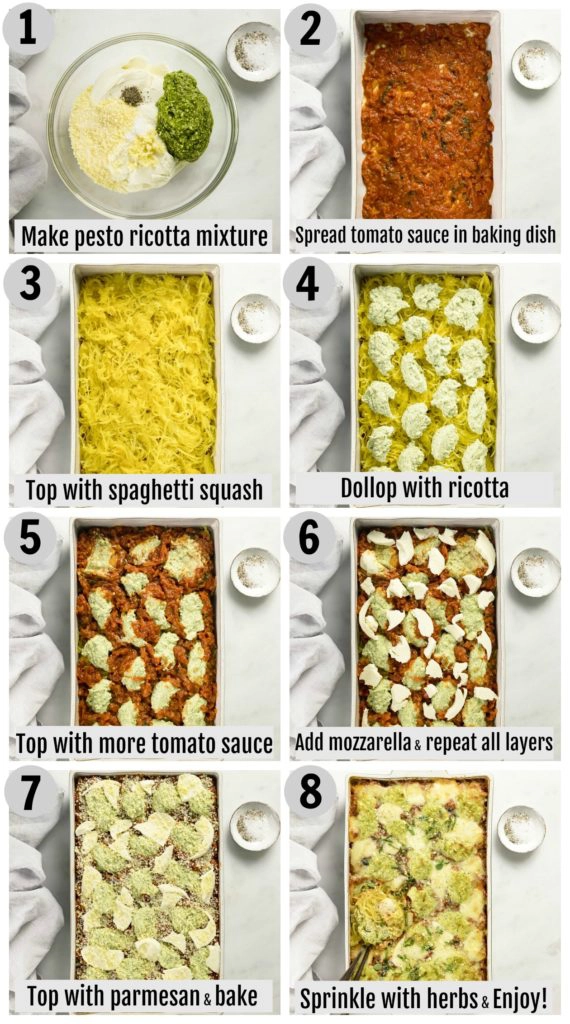
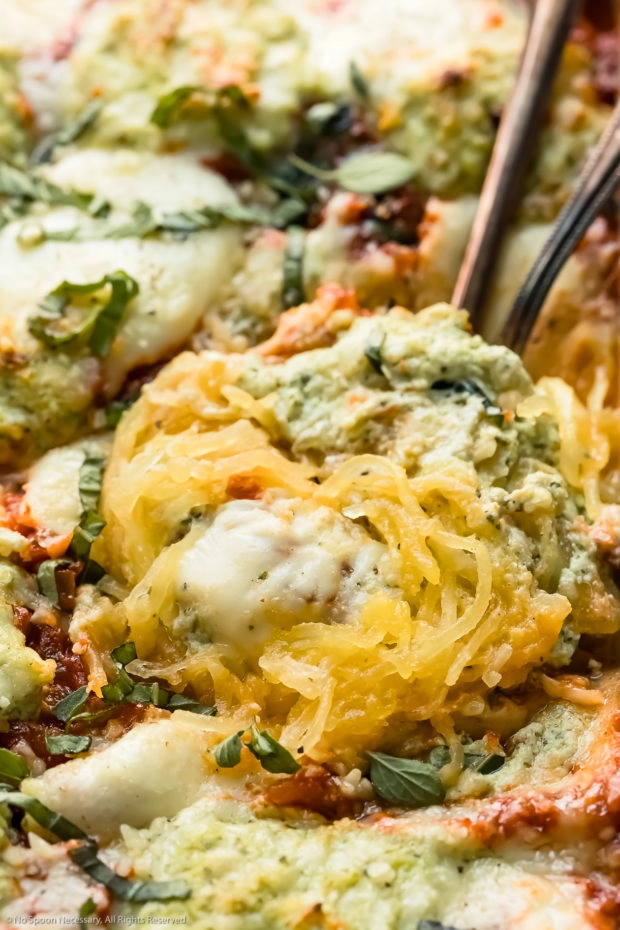
Dahn
This looks and sounds amazing. What a great comfort dish that is also healthy. Great way to start the New Year resolutions.
Katerina
This dish looks absolutely divine, Cheyanne! I am loving all your photos – absolutely droolworthy. Thanks so much for sharing, I can’t wait to make this!
Jennifer @ Seasons and Suppers
I clearly need to be picking up some spaghetti squash ASAP! This looks fabulous and I love it with the pesto. marinara and all that cheese goodness 🙂
Marissa
What a fabulous dish, Chey! You are seriously magic with spaghetti squash and what way to reinvent lasagna (one of my all time favorite comfort foods). So excited to give this beauty a try!
Mary Ann | The Beach House Kitchen
Holy Moly Chey!! This looks absolutely DELISH! I’m always up for a healthier version of anything and this I’m sure will not disappoint. I just want to grab one of those forks and dig in. Can’t wait to give this recipe a try!
Kelsie | the itsy-bitsy kitchen
Ooohhh I can taste this already! I’m a lasagna fanatic, especially when it’s made with pesto. I can’t wait to try it with spaghetti squash! You’re a genius!
angiesrecipes
Such a perfectly comforting, healthy and delicious meal! I love that homemade spaghetti sauce too.